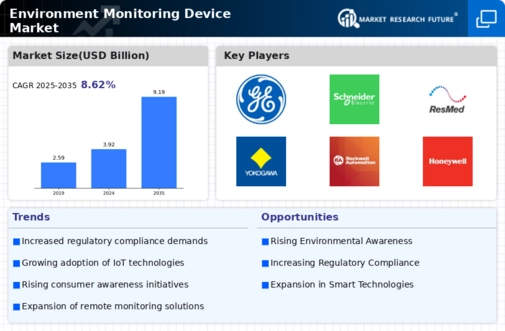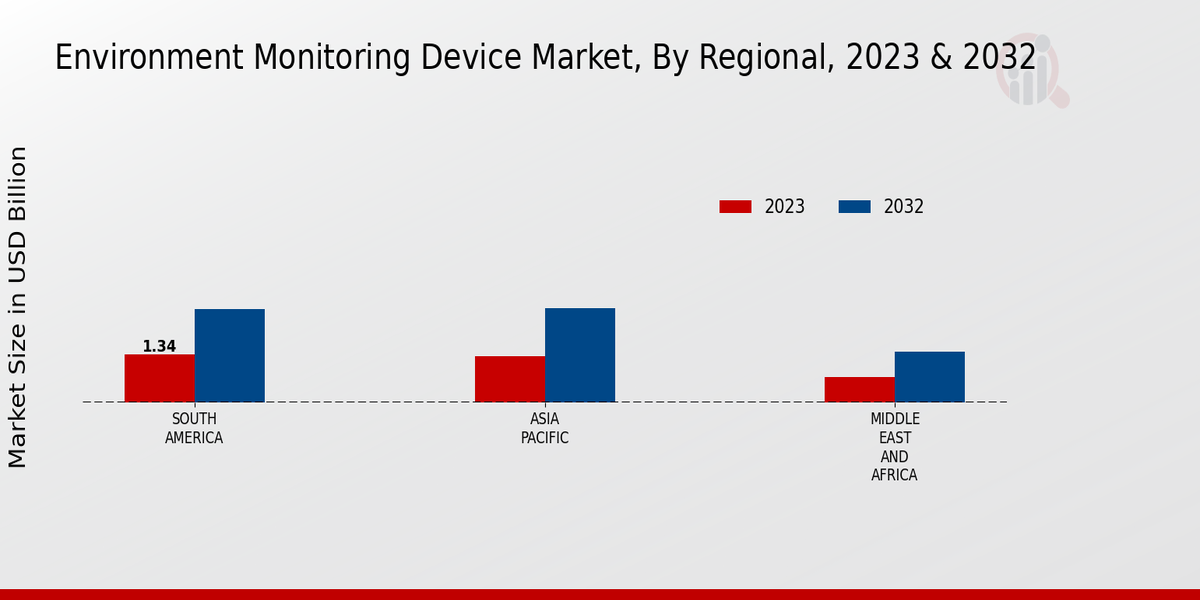Regulatory Frameworks
The Global Environment Monitoring Device Market Industry is significantly influenced by stringent regulatory frameworks aimed at environmental protection. Governments worldwide are enacting policies that mandate regular monitoring of air and water quality, thereby driving the demand for monitoring devices. For instance, the implementation of the Clean Air Act in various countries necessitates the use of advanced monitoring technologies to ensure compliance. These regulations not only create a stable market environment but also encourage innovation among manufacturers. Consequently, the industry is poised for growth as organizations invest in compliant monitoring solutions to meet regulatory requirements and enhance their sustainability efforts.
Market Growth Projections
The Global Environment Monitoring Device Market Industry is on a trajectory of substantial growth, with projections indicating a market value of 3.92 USD Billion in 2024 and an anticipated increase to 9.19 USD Billion by 2035. This growth is underpinned by a compound annual growth rate (CAGR) of 8.05% from 2025 to 2035. The expansion of the market reflects the increasing recognition of the importance of environmental monitoring across various sectors, including government, industry, and academia. As stakeholders prioritize sustainability and compliance with environmental regulations, the demand for advanced monitoring devices is expected to rise, driving innovation and investment in the industry.
Technological Advancements
Technological innovations play a pivotal role in the Global Environment Monitoring Device Market Industry. The integration of IoT, artificial intelligence, and big data analytics enhances the capabilities of monitoring devices, enabling real-time data collection and analysis. For example, smart sensors can now detect pollutants with greater accuracy and provide actionable insights for environmental management. This evolution not only improves the efficiency of monitoring systems but also attracts investments, as stakeholders seek to leverage cutting-edge technologies. As a result, the market is expected to grow significantly, with a projected CAGR of 8.05% from 2025 to 2035, reaching an estimated 9.19 USD Billion by 2035.
Rising Environmental Concerns
The Global Environment Monitoring Device Market Industry is experiencing growth driven by increasing awareness of environmental issues. Governments and organizations are prioritizing sustainability, leading to heightened demand for monitoring devices. For instance, initiatives aimed at reducing carbon emissions and improving air quality are prompting investments in advanced monitoring technologies. This trend is reflected in the projected market value of 3.92 USD Billion in 2024, indicating a strong commitment to environmental stewardship. As stakeholders recognize the importance of data-driven decision-making, the adoption of these devices is likely to accelerate, contributing to a healthier planet.
Public Awareness and Engagement
Public awareness regarding environmental issues is a driving force behind the Global Environment Monitoring Device Market Industry. As communities become more engaged in sustainability efforts, there is a growing demand for monitoring devices that provide transparency and accountability. Educational campaigns and grassroots movements are fostering a culture of environmental stewardship, prompting individuals and organizations to invest in monitoring technologies. This shift in public perception is likely to influence market dynamics, as stakeholders seek to adopt solutions that align with their values. The increased focus on environmental responsibility is expected to sustain market growth, creating opportunities for innovation and collaboration within the industry.
Urbanization and Industrialization
Rapid urbanization and industrialization are key drivers of the Global Environment Monitoring Device Market Industry. As cities expand and industries proliferate, the need for effective environmental monitoring becomes increasingly critical. Urban areas often face challenges such as air pollution and waste management, necessitating the deployment of monitoring devices to assess environmental impacts. For example, metropolitan regions are investing in air quality monitoring systems to address pollution concerns. This trend is likely to propel market growth, as the demand for comprehensive monitoring solutions rises in tandem with urban development, ensuring a sustainable balance between growth and environmental health.





















